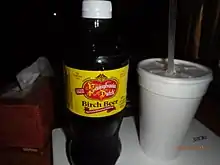Birch beer
Birch beer is a beverage, commonly found as a carbonated soft drink made from herbal extracts and birch bark. [1][2][3][4][5] There are dozens of brands of birch beer available.[6]

Ingredients
The one ingredient used in all recipes of birch beer is birch sap. Most recipes use some fermentation, but the amount of alcohol in the beverage depends on the brand. The process of fermenting birch syrup is done using baker's yeast.[7] The process of fermentation is done to decompose sugar to alcohol. Other common ingredients include sugar, cinnamon, vanilla beans, and water.[8] Homemade recipes of birch beer also include honey and malt.[9]
Birch extract preparation
Various types of birch beer made from birch bark are available as well, distinguished by color. The color depends on the species of birch tree from which the birch oil is extracted (though enhancements by artificial coloring are commonly present). Popular colors include brown, red, blue and clear (often called white birch beer), though others are possible.
After the bark is collected, it is distilled to make birch oil.[10] The oil is added to the carbonated drink to give it the distinctive flavor, reminiscent of wintergreen and methyl salicylate. Black birch is the most common source of extract in the northeastern region of the United States, where that species is indigenous.[11]
Birch beer varieties
Birch beer is most commonly found in the Northeastern United States and Newfoundland in Canada.
In the dairy country of southeastern and central Pennsylvania, an ice cream soda made with vanilla ice cream and birch beer is called a "birch beer float", while chocolate ice cream and birch beer makes a "black cow".

Alcoholic birch beer, in which the birch sap is fermented, has been known from at least the seventeenth century. The following recipe is from 1676:[12]
To every Gallon whereof, add a pound of refined Sugar, and boil it about a quarter or half an hour; then set it to cool, and add a very little Yeast to it, and it will ferment, and thereby purge itself from that little dross the Liquor and Sugar can yield: then put it in a Barrel, and add thereto a small proportion of Cinnamon and Mace bruised, about half an ounce of both to ten Gallons; then stop it very close, and about a month after bottle it; and in a few days you will have a most delicate brisk Wine of a flavor like unto Rhenish. Its Spirits are so volatile, that they are apt to break the Bottles, unless placed in a Refrigeratory, and when poured out, it gives a white head in the Glass. This Liquor is not of long duration, unless preserved very cool. Ale brewed of this Juice or Sap, is esteem'd very wholesome.
References
- "Birch Beer". Aussie Recipes. Retrieved 2020-11-17.
- Grimes, David. "How to Make Homemade Birch Beer". www.leaf.tv. Retrieved 2019-05-30.
- "What Is Birch Beer? (with pictures)". wiseGEEK. Retrieved 2019-05-30.
- "Birch Beer ~ Small Batch Recipe". Practical Self Reliance. 2018-05-31. Retrieved 2019-05-30.
- "How to Make Birch Beer". Tastessence. 21 June 2011. Retrieved 2019-05-30.
- "anthony's root beer barrel – birch beers". Retrieved 31 May 2016.
- Mitchell, James K. (1995-10-01). "Fun Microbiology: Making Root Beer & Other Naturally Carbonated Beverages". The American Biology Teacher. 57 (7): 432–435. doi:10.2307/4450033. ISSN 0002-7685. JSTOR 4450033.
- Brewing, Renegade (2021-03-20). "What Is Birch Beer? (Definition, History & Recipe)". Renegade Brewing. Retrieved 2022-12-07.
- "Sap on Tap: Father and Son Duo Use Black Birch Sap as Key Ingredient in Noble Birch Beer". Massachusetts Brewers Guild. Retrieved 2022-12-07.
- Chris Buckner (6 July 2017). "How to Make Birch Oil Directly From Birch Bark". Wide Open Spaces.
- "Betula lenta". North Carolina Extension Gardener Plant Toolbox.
- Worlidge, John, Vinetum Britannicum … (London, England: Thomas Dring, 1676), p. 176. See p. 176 (1678 ed.).
External links


